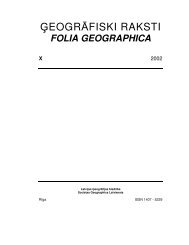eogrÄfiski raksti folia geographica xii - Ä¢eogrÄfijas un Zemes zinÄtņu ...
eogrÄfiski raksti folia geographica xii - Ä¢eogrÄfijas un Zemes zinÄtņu ...
eogrÄfiski raksti folia geographica xii - Ä¢eogrÄfijas un Zemes zinÄtņu ...
Create successful ePaper yourself
Turn your PDF publications into a flip-book with our unique Google optimized e-Paper software.
33<br />
NATURE RESEARCH<br />
After vernal equinox, the 850 hPa temperature and pseudopotential temperature curves<br />
get much steeper and begin to level out only in J<strong>un</strong>e. It was fo<strong>un</strong>d that in April to August the<br />
average air mass was warmed subpolar air xPs. Furthermore, the May air mass exhibited a<br />
greater similarity to continental air or higher degree of transformation, but the September<br />
average air mass, still within the limits of one standard deviation of xPs air, showed more<br />
similarity to mP air. The xPs air mass is on average 3° to 4° warmer than mP air at 850 hPa<br />
level, but the pseudopotential temperatures differ even more (Figure 8). During Latvian springsummer<br />
seasons, xPs air produces warm to temperate weather and local convection is rather<br />
good. When a high-pressure ridge develops, s<strong>un</strong>ny weather sets in with fair weather clouds and<br />
mid-day temperature may rise to 24 or 25°C. Under cyclonal circulation, the weather is slightly<br />
cooler, partly cloudy and rain alternates with s<strong>un</strong>ny weather.<br />
The mapping of European air mass source regions generated by Geb (1979) shows a shift<br />
of mid-latitude (Sp) air mass source region to the north, which starts in spring. While in April<br />
and May Latvia still lies on the edge of the xP air region, in summer months the northern<br />
bo<strong>un</strong>dary of mid-latitude xSp air (limited by +15 o C isotherm over land) expands to the Finnish<br />
Gulf and to the north of the 60°N parallel over the Scandinavian peninsula. Thus, in summer<br />
<strong>un</strong>der favourable conditions, an air mass over Latvia would potentially show the typical<br />
characteristics of mid-latitude xSp air. Apparently, the closeness of Latvia to the northern edge<br />
of mid-latitudes entails the damping of radiative heating in the warm part of the year by<br />
relatively high occurrence of cool air (mP, xP).<br />
To summarize, all year ro<strong>un</strong>d the average monthly air mass in Latvia is transformed<br />
maritime air, because Latvia lies in a transitional position, where maritime air moving from<br />
west to east gradually is transformed into continental air, i.e. the continentality increases. This<br />
general tendency is cancelled or co<strong>un</strong>teracted by the influence of the Baltic Sea. Bukantis<br />
[1995] fo<strong>un</strong>d that the most obvious influence of the Baltic Sea on climate, depending on land<br />
relief, was in the coastal belt about 30-100 km wide.<br />
The annual cycle of air mass frequency may be divided into two periods with transition<br />
periods between them. The pattern of air mass occurrence forms against a backgro<strong>un</strong>d of<br />
variation of the properties of each air mass from month to month as the temperature of an air<br />
mass changes and, consequently, its moisture content and stability, both at the surface and at<br />
850 hPa level. By the annual occurrence of different air mass types and their influence on<br />
weather, three kinds of air masses may be distinguished: all-season, seasonal and irregular.<br />
All-season air masses, for instance, xP, mP, cPs, xPs, arrive in Latvia each year and each<br />
month, showing smaller or greater annual variation. Others, such as xA, mA, cP, xSp, xS, are<br />
strongly seasonal air masses. These arrive each year and while showing annual variations,<br />
pertain to certain months with little or no influence the rest of the year. Irregular air masses,<br />
such as cA, cS, are strongly seasonal, do not arrive in Latvia each year, and bring extreme (the<br />
coldest and the hottest) weather. The all-season air masses play a double role, making a<br />
backgro<strong>un</strong>d for seasonal air masses to stand out against, and at the same time may show<br />
themselves as a prevailing air mass type. The maritime subpolar air mP may be considered the<br />
core air mass. While the role of seasonal and irregular air masses is <strong>un</strong>equivocal – these bring<br />
either warm or cold weather (the surface daily mean temperatures are clearly above or below the<br />
monthly mean temperatures), the all-season air masses exert an almost contradictory influence<br />
on weather. In October-March these masses manifest themselves as warm or temperate air, in<br />
transitional seasons as temperate, and in J<strong>un</strong>e-July as cool air.<br />
October to mid-April shows a particular combination of air masses. Within the 11-year<br />
period (1990-2000), the frequency of mP air together with xP air (its first modification) was<br />
above 30% or more specifically from 30% (October) to 38% (January), excluding the days with<br />
frontal passages. At that time of the year, these air masses manifest themselves as warm or<br />
temperate ones, and interchange with cold air masses xA, mA, cP (the surface daily mean<br />
temperatures are clearly below the monthly mean temperatures). The latter bring about and<br />
maintain winter weather (snowfalls/clear skies and negative air temperatures). The occurrence<br />
of each separate cold air mass varies from month to month while their frequency is within 6 to<br />
18%, but altogether cold or winter air masses dominate during 30 to 40% of days (fronts<br />
excluded), excepting January, which had a slightly lower frequency (27%). The frequency of

















